The accuracy of the long-term global instrumental temperature record – especially the data obtained before the 1970s – wholly rests on the assumption that sailors obtained precisely reliable temperature measurements as they pulled wooden or canvas buckets out of the water from ships at random depths, locations, and times of day. They didn’t.
It has long been known that pulling a bucket out of the water from a ship is rooted in serious error, rendering the sea surface temperature (SST) data obtained nearly useless. Ashford (1948) summarized some of the more salient reliability problems with this method of measurement.
• The initial temperature of the bucket is generally different from that of the sea.
• The water in the bucket may change its temperature before the reading is taken owing to the processes of heat exchange and evaporation.
• The initial temperature of the thermometer is generally different from that of the sample.
• The thermometer is liable to scale errors.
• Owing to thermal lag, the thermometer may take an appreciable time to indicate the true temperature of the sample.
• If the thermometer is removed from the bucket when taking the reading, it may no longer indicate the true water temperature.
• The temperature may be read incorrectly.
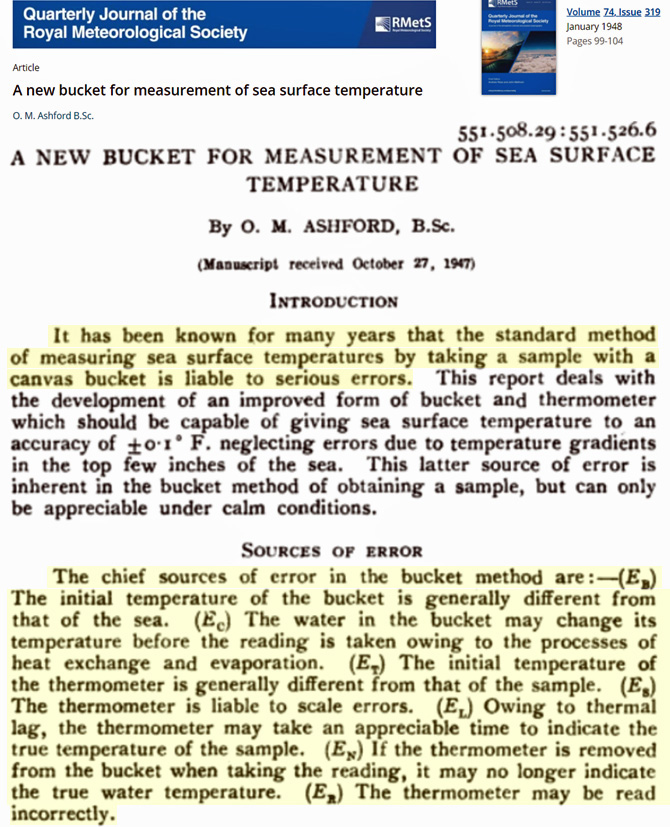
Image Source: Ashford, 1948
Pervasive systematic observational errors
There are “pervasive systematic observational errors” associated with using buckets that “affect the whole observational system and change over time” (Kennedy, 2014). The data collection errors in even one measurement from one location are much larger than the alleged long-term tenths-of-a-degree “global” SST changes over decades.
“A single SST measurement from a ship has typical combined random and systematic error uncertainty of around 1 K to 1.5 K.”
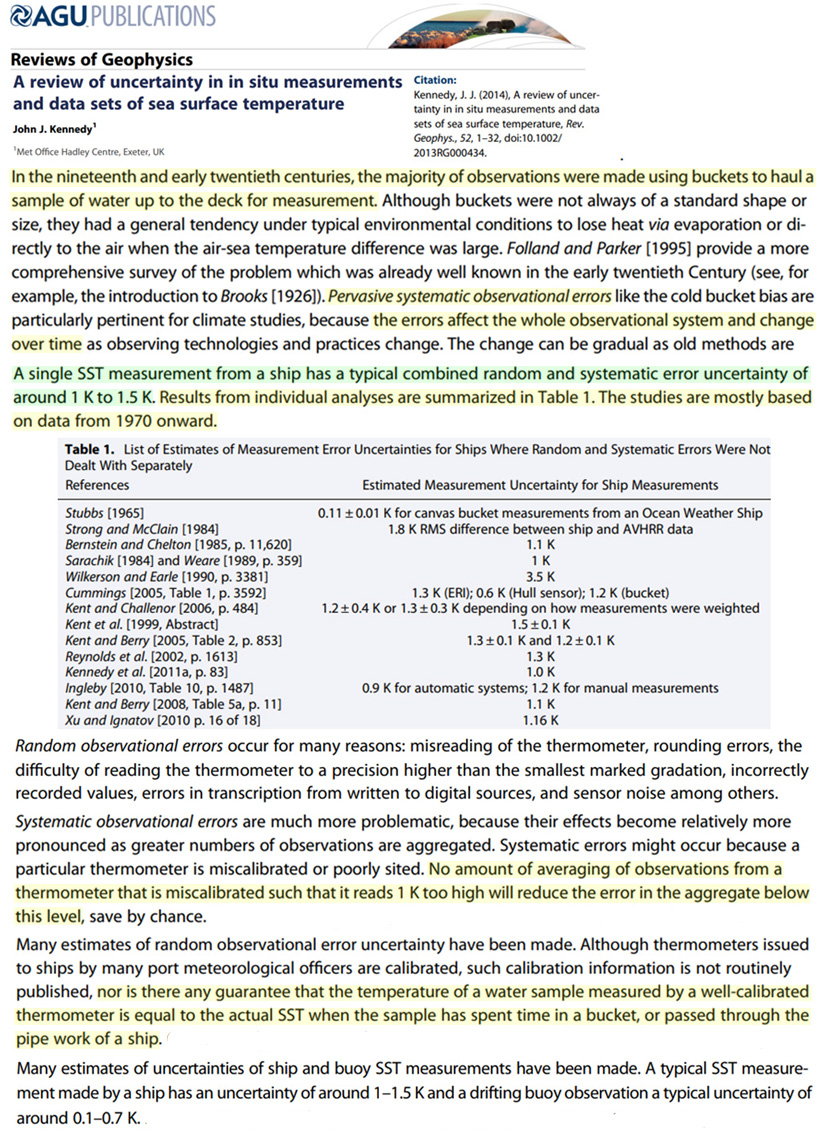
Image Source: Kennedy, 2014
Depth sampling errors
In the ocean, water temperature varies by multiple degrees according to depth, as there are “measurable temperature gradients within the depth range of ship SST measurements” (Kennedy, 2014). The temperature at 1 meter depth could be 2°C warmer than the temperature at 10 meters. There was no uniform systematic method governing how deep the buckets needed to be as they were lowered into the ocean.
When pulling the bucket out of the water, there was no way to isolate a specific depth measurement anyway, as it was all mixed together as the bucket was lifted to the surface. To control for depth variations, sailors would have needed to regularly measure near-surface waters at a range of depths at specific times of the day and evening. They didn’t do this, of course.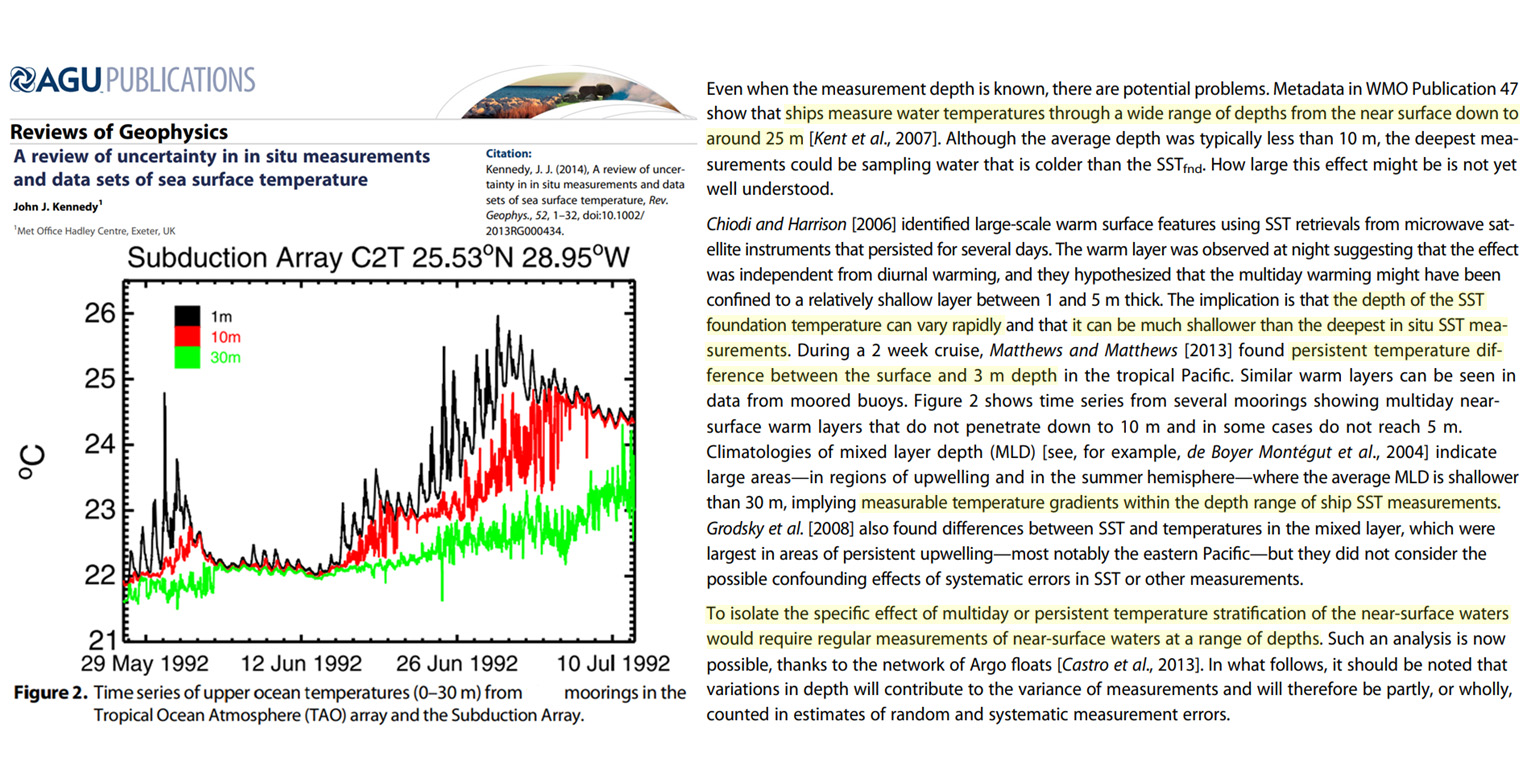
Image Source: Kennedy, 2014
Diurnal variation errors
Over the span of just 10 to 12 hours the temperature of near-surface sea water can vary by 5°C (Kawai and Wada, 2007) due to the degree of sunshine duration and intensity (clear-sky vs. overcast). In tropical locations, SSTs can change by as much as 8°C within hours, depending on the time of day (Randall et al., 2020).
Therefore, to accurately record SST measurements requires obtaining maximum and minimum temperature readings. This would mean sailors needed to be lowering buckets into the water at uniform and standardized times of the day, or perpetually measuring temperatures throughout the day and night to control for diurnal variability. They didn’t do this, of course.
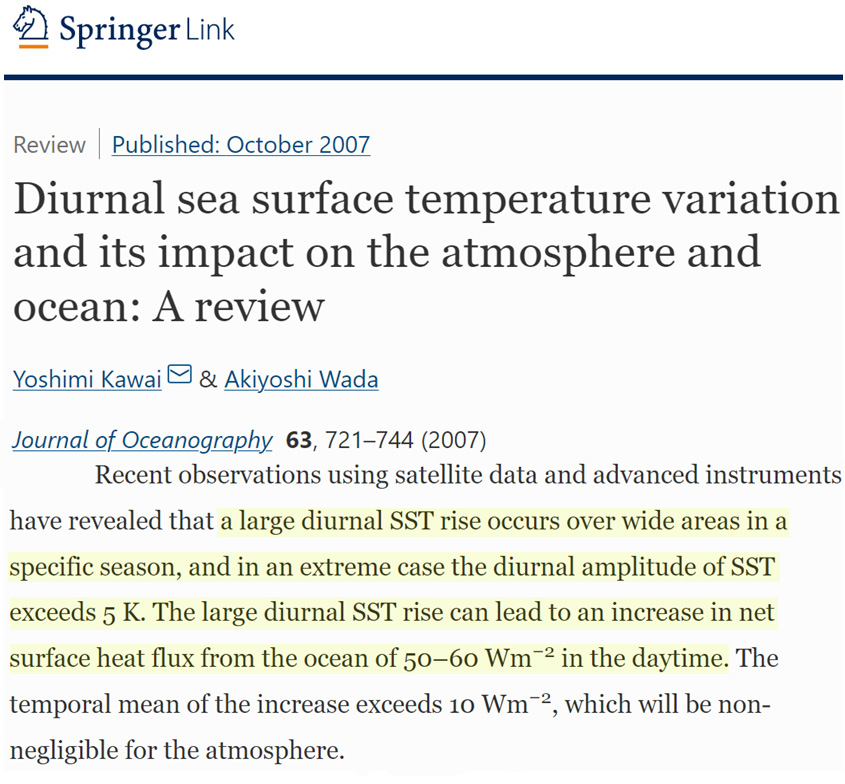
Image Source: Kawai and Wada, 2007
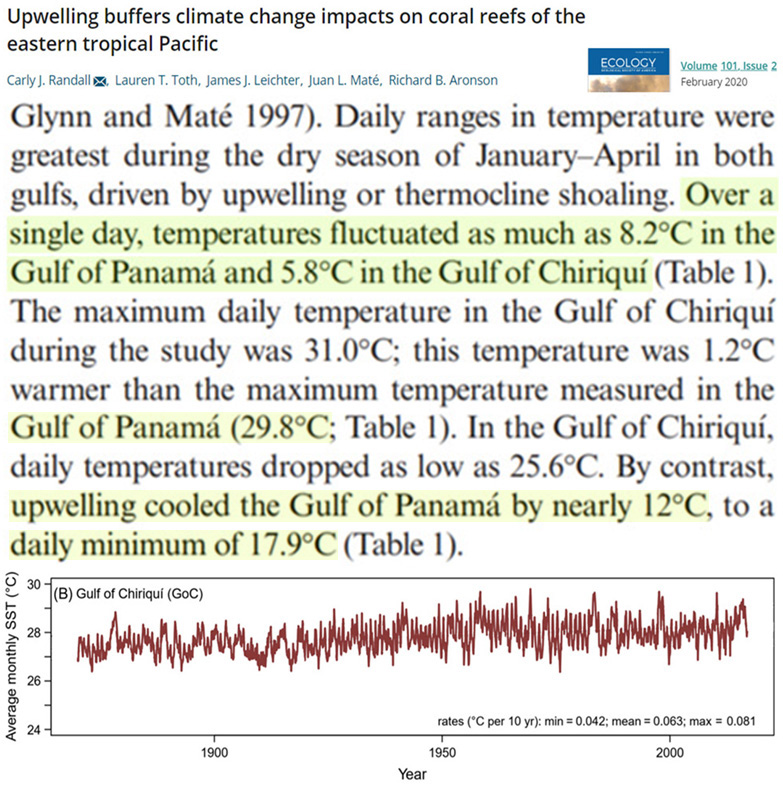
Image Source: Randall et al., 2020
“Largely missing” observational coverage means modeled extrapolations are needed
Perhaps the most underreported problem with obtaining reliable SST measurements prior to recent decades has been the ridiculously non-global nature of the coverage. Most pre-1970s SST measurements came from coastal waters in the North Atlantic, Mediterranean, and Indian Oceans.
Per Folland and Parker (1995), there has long been “sparse coverage of the Pacific,” and “even in recent decades [1970s and 1980s], the Southern Ocean south of 45°S is largely missing.” If we have “largely missing” SST data from 45°S to the coasts of Antarctica up until the 1980s, we effectively cannot say we have a pre-1980s global temperature record, as this represents nearly 20% of the Earth’s surface.
And because the coverage is so poor, the utilization of modeled interpolations of what the SSTs might have been has become the accepted standard in temperature derivation.
In 5° grid boxes, for example, monthly anomalies have been found to be “differing by more than 2.25 degC from the averages of surrounding values,” and “biases occasionally exceed 1 degC in individual months” (Folland and Parker, 1995). Consequently, the anomalies are “replaced by values interpolated from surrounding squares and from adjacent months.”
So they’re not actual measurements of SST, but interpolations of what they might have been using modeled assumptions.
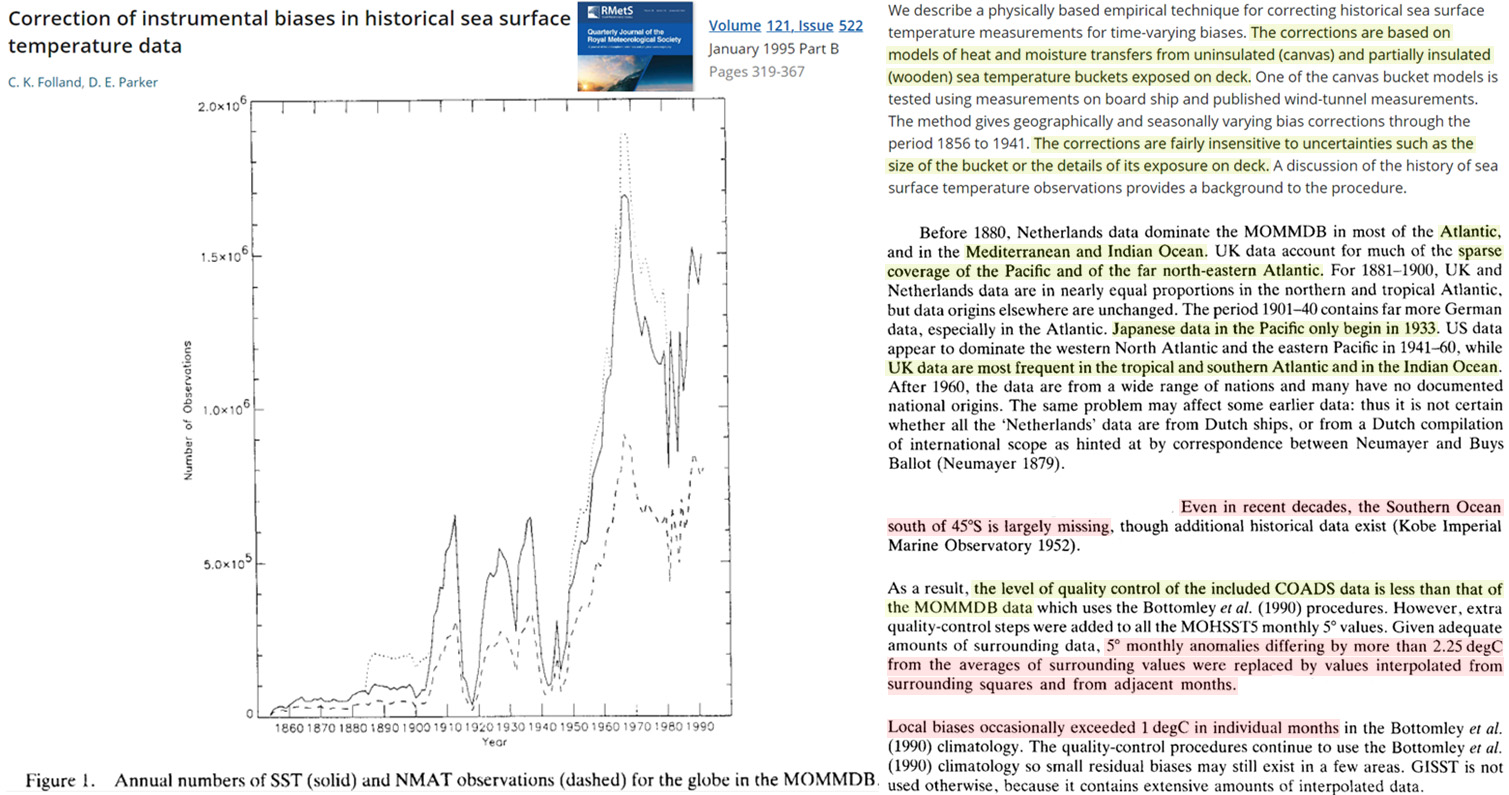
Image Source: Folland and Parker, 1995
NOAA’s Thomas Karl experienced some notoriety a few years ago as the author of a “pause-buster” paper because he replaced buoy data (that showed little warming) with “unreliable data from ship intakes” so as to eliminate the problematic global warming hiatus.
But back in 1989, Karl not only reported there had been no global warming from 1921 to 1979, but that there are “large geographic areas of the oceans that have not been adequately sampled” (Karl et al., 1989), especially the tropical Pacific and south of 40°S.
Specifically, for every year from about 1850 to 1950, under 10% of the global ocean’s 2° grid boxes averaged 10 or more sea surface observations (from pulling buckets out of the water) per month. That’s the extent of the instrumental “global” record for 71% of the Earth’s surface.
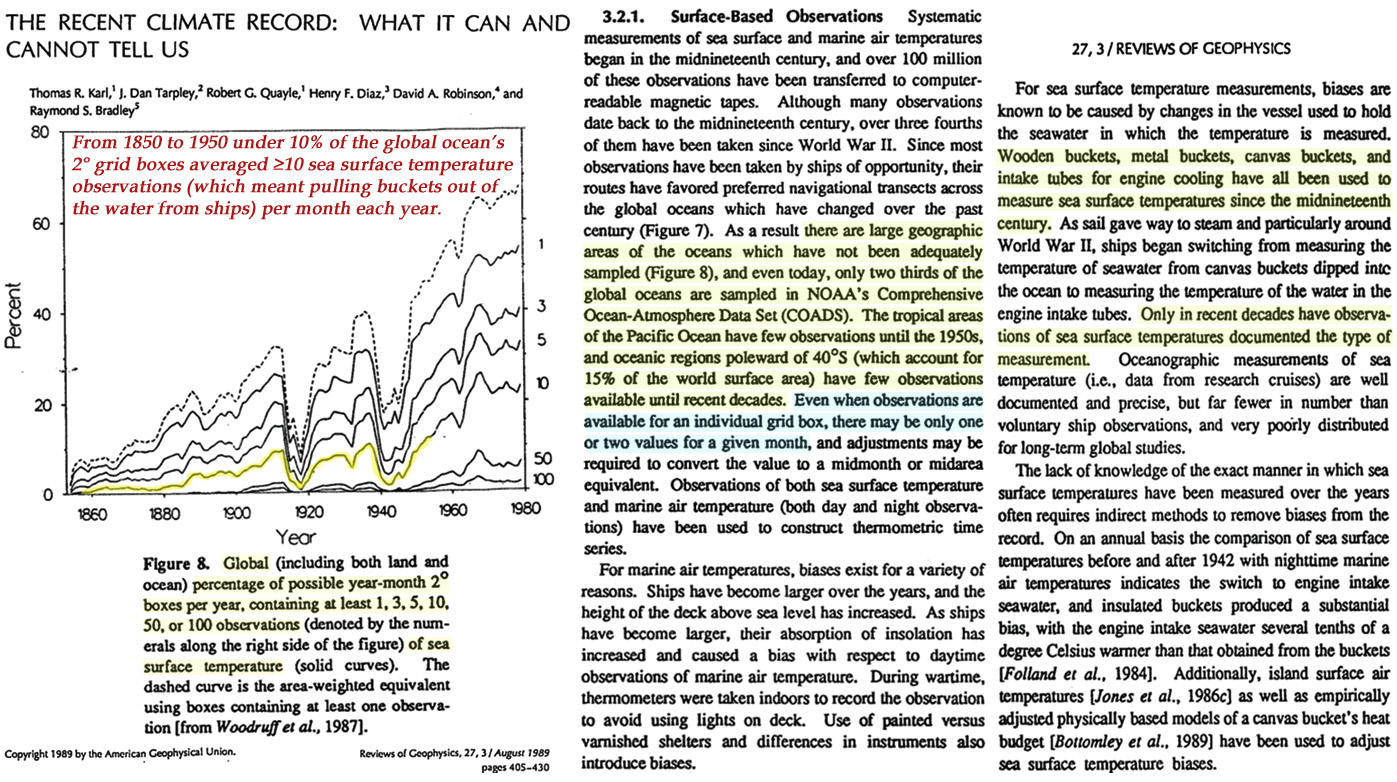
Image Source: Karl et al., 1989
Given the pervasive systematic errors, depth temperature variability, diurnal temperature variability, need for modeled interpolations, and shamefully poor non-global sampling coverage associated with sailors pulling buckets out of the water at random times of the day or night in the derivation of a “global” sea surface temperature record, it’s not surprising that temperature data set overseers privately admit to one another that SST data are “mostly made up.”
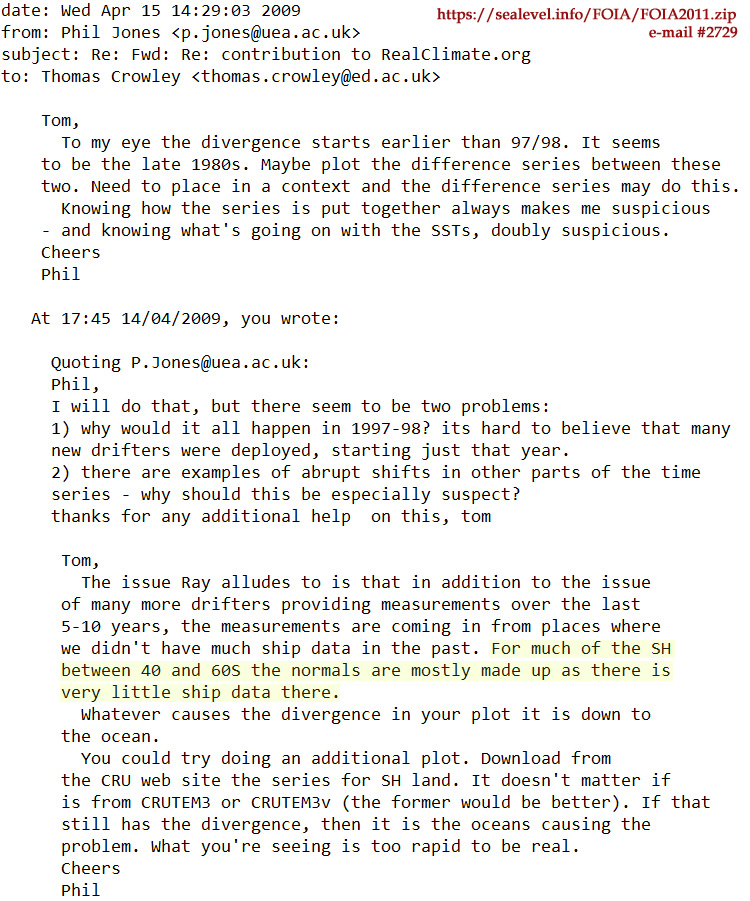





Good to see “different from” instead of that nasty and wrong “different than”.
[…] Pre-1970s ‘Global’ Sea Surface Temp Measurements Are No More Reliable Or Accurate Than G… […]
From past experience swimming in the Baltic in the summer, there can be a large difference in water temperature between the surface and even 50 cm below it 🙂
Thanks for all the useful information.
Welcome to the real-time HTML editor!
Type HTML in the textarea above, and it will magically appear in the frame below.
RE – SST, and data “adjustment” (tampering) in general.
From a previous post of mine.
”The analysis presented here indicates that, outside the immediate war-time period, these adjustments are distorting and degrading the data rather than improving it.”
https://judithcurry.com/2012/03/15/on-the-adjustments-to-the-hadsst3-data-set-2/amp/
…as anyone who has taken even an introductory statistics course should know.
Also, at least some scientists were concerned enough to petition Congress to act.
“A recent letter from 300 scientists is requesting that Congress assure that the Data Quality Act is complied with, which NOAA has not done regarding both the U.S. and global empirical temperature observations.”
https://www.c3headlines.com/2016/01/a-legitimate-question-how-much-of-modern-global-warming-is-fabricated-by-noaa-nasa.html
Congress didn’t act. No surprise there.
Good to know there are still scientists pointing out the shoddy methods and the abuse of data by the warmists.
Thx, Kenneth!
PS – this person (“Hum”) knows…
https://notrickszone.com/2019/03/31/fabricating-a-warming-nasa-now-altering-unadjusted-data-to-create-new-warmer-unadjusted-data/#comment-1299879
I would only add that, if one does create an adjusted data set, he should never misrepresent it as real data, even if he has saved the original one that he adjusted.
https://youtu.be/5MBCwqkyStQ?t=6911
http://en.kremlin.ru/events/president/news/69299
Ilya Doronov: “Did we build the Nord Stream 2 pipeline for no reason?”
Vladimir Putin: “No, we do not build anything for no reason. We received the necessary technology and we did our work properly. If necessary, we will put Nord Stream 2 into operation. If this matter is of interest to you, I can talk about it in more detail, however, I would prefer not to waste time on it.”
Ilya Doronov: “No, you said a lot on the topic, you said we were ready and the pipeline had been built.”
Vladimir Putin: “Nord Stream 1 is practically closed, and everyone is saying: ‘Russia is using its energy weapon.’ More nonsense and rubbish. What weapon are we using? We supply as much gas as our partners need, as much as they order. We are not pumping gas into the air but supplying the amount ordered. We fill the orders that we receive.
What has happened? The operation of one of the two gas pipelines running across Ukraine was suspended by Ukraine for a made-up reason, alleging that there was no control over it. They closed it themselves. It was not us who closed it, Ukraine did it. This is my first point.
Another pipeline, Yamal–Europe, runs across Poland. Poland imposed sanctions on this gas pipeline and suspended its functioning. Was it us who did this? No, the Poles did it. The Ukrainians did it and the Poles.
Regarding Nord Stream 1, our German partners have agreed that all technical aspects of Nord Stream 1, including the maintenance of gas-pumping turbine units, are subject to British law because – I myself was unaware of this and learned about this from Mr Miller – Gazprom had to sign a contract for the maintenance of these units made by Siemens not with the Siemens main office but with its subsidiary based in the United Kingdom, which slapped sanctions on Gazprom, and agreed to repair the turbines at a Siemens plant in Canada.
What do we have to do with all of that? Canada finally took it but yielded to numerous requests coming from Germany and gave it to Germany, whereas under an agreement with a Siemens subsidiary in the UK, the turbines were to be shipped straight to St Petersburg. Logistics arrangements have changed and the contract has to be revised. The British-based Siemens subsidiary will not even respond to Gazprom’s inquiries.
You can take as many photos with the turbine as you want, but give us the documents, for crying out loud. This is our property. We need to understand the legal status of this property and its technical condition. They give us nothing but chit-chat.
The last turbine is now out of order, so Siemens representatives came to look at it. There is an oil leak, which is an explosion and fire hazard. There is no way for the turbine to remain operational given its current condition. Give us the turbines, and we will turn on Nord Stream 1 overnight. They do not give us anything. They say we are weaponising it. What are they talking about? They themselves messed things up big time and are now not sure what to do about it. They drove themselves into a sanctions dead end.
There is only one way out. In Germany, people are rallying to turn on Nord Stream 2. We are supportive of the demands by German consumers and we are ready to turn it on as early as tomorrow. All we need to do is press the button, but we are not the ones who imposed sanctions on Nord Stream 2. It was done under pressure from the United States. Why is it exerting pressure? Because it wants to sell its gas for a pretty penny. We are aware of the position of the former US administration as well. They said, ‘Yes, we sell at a higher price, but let them buy ours because we offer them protection.’ Let them buy then if they choose to. We will sell our product.”
https://rmx.news/article/without-energy-no-economy-can-run-german-companies-warning-they-have-no-electricity-contract-could-signal-disaster/
And there I was 60 years ago as an old sea going radio officer on one of the old OBS ships dutifully taking 4 hourly readings across the wide Pacific and transmitting them by Morse code to Bracknell all to no avail
Done a lot of that over the years – in the “Olden Days” : If you’ve never stood on the bridge wing of a ship in a howling gale helping the 3rd mate take a reading on a hand held mercury thermometer, in a canvas bucket, by torch light, then you can’t really claim you understand the core reasons why temperatures up to around 1980 differed from those from 2000 onwards and why there was a slow shift during the changeover period. Experience helps a lot !
Great article
Mr. Richard hits a home run
No reliable data before the use of satellites in 1979
No comparison of different sea surface measurement methodologies all used in the same location, to see if measurement methodology changes caused a warming trend.
Buckets, versus engine water intake from different depths, etc.
Sailors with buckets mainly in various Northern Hemisphere shipping lanes
is not good science. Did they smoke a cigarette before dipping the thermometer in the bucket? Must be a huge margin of error.
But the warming since 1979 is real — also harmless,
and has slowed to near zero in the past seven years
Guess work kills, knowledge may save.
Always worth a watch
https://www.youtube.com/watch?v=lmjaNO5DD_Q
and
https://www.youtube.com/watch?v=fsYdhRhKURg
The Natural Warming of the Global Oceans – Parts 1 & 2
[…] Pre-1970s ‘Global’ Sea Surface Temp Measurements Are No More Reliable Or Accurate Than G… […]
[…] Pre-1970s ‘Global’ Sea Surface Temp Measurements Are No More Reliable Or Accurate Than Guessing […]
Some years ago David W.J. Thompson at al. attempted to explain “A large discontinuity in the mid-twentieth century in observed global-mean surface temperature“, published in NATURE, [Vol.453, 29May2008]. Whereas they confirmed that the Earth warmed from 1910 to1940** the subsequent cooling is explained very superficially, namely by a “variety of physical factors, such as atmosphere–ocean interactions and anthropogenic emissions of sulphate aerosols” and of “uncorrected instrumental biases in the sea surface temperature record”. That the large discontinuity has a strong correlation with World War II is not even mentioned.
Concerning SST taken in the Pacific and Atlantic during WWII see two essays:
http://www.oceanclimate.de/English/Pacific_SST_1997.pdf
http://www.oceanclimate.de/English/Atlantic_SST_1998.pdf
And “The SST Discontinuity in the 1940s – But no answer
https://oceansgovernclimate.com/the-sst-discontinuity-in-the-1940s-but-no-answer/
[…] Pre-1970s ‘Global’ Sea Surface Temp Measurements Are No More Reliable Or Accurate Than Guessing […]